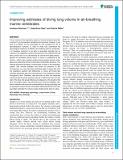Files in this item
Improving estimates of diving lung volume in air-breathing marine vertebrates
Item metadata
| dc.contributor.author | Fahlman, Andreas | |
| dc.contributor.author | Sato, Katsufumi | |
| dc.contributor.author | Miller, Patrick | |
| dc.date.accessioned | 2021-06-24T23:35:48Z | |
| dc.date.available | 2021-06-24T23:35:48Z | |
| dc.date.issued | 2020-06 | |
| dc.identifier | 269040284 | |
| dc.identifier | c0e3b0e1-e2a9-4bf1-94b9-1a8c16e877eb | |
| dc.identifier | 85087139521 | |
| dc.identifier | 32587107 | |
| dc.identifier | 000576692600004 | |
| dc.identifier.citation | Fahlman , A , Sato , K & Miller , P 2020 , ' Improving estimates of diving lung volume in air-breathing marine vertebrates ' , Journal of Experimental Biology , vol. 223 , jeb216846 . https://doi.org/10.1242/jeb.216846 | en |
| dc.identifier.issn | 0022-0949 | |
| dc.identifier.uri | https://hdl.handle.net/10023/23420 | |
| dc.description.abstract | The air volume in the respiratory system of marine tetrapods provides a store of O2 to fuel aerobic metabolism during dives; however, it can also be a liability, as the associated N2 can increase the risk of decompression sickness. In order to more fully understand the physiological limitations of different air-breathing marine vertebrates, it is therefore important to be able to accurately estimate the air volume in the respiratory system during diving. One method that has been used to do so is to calculate the air volume from glide phases - periods of movement during which no thrust is produced by the animal - which many species conduct during ascent periods, when gases are expanding owing to decreasing hydrostatic pressure. This method assumes that there is conservation of mass in the respiratory system, with volume changes only driven by pressure. In this Commentary, we use previously published data to argue that both the respiratory quotient and differences in tissue and blood gas solubility potentially alter the mass balance in the respiratory system throughout a dive. Therefore, near the end of a dive, the measured volume of gas at a given pressure may be 12-50% less than from the start of the dive; the actual difference will depend on the length of the dive, the cardiac output, the pulmonary shunt and the metabolic rate. Novel methods and improved understanding of diving physiology will be required to verify the size of the effects described here and to more accurately estimate the volume of gas inhaled at the start of a dive. | |
| dc.format.extent | 7 | |
| dc.format.extent | 474884 | |
| dc.language.iso | eng | |
| dc.relation.ispartof | Journal of Experimental Biology | en |
| dc.subject | Diving physiology | en |
| dc.subject | Gas exchange | en |
| dc.subject | Lung function | en |
| dc.subject | Respiratory physiology | en |
| dc.subject | QH301 Biology | en |
| dc.subject | QP Physiology | en |
| dc.subject | Animal Science and Zoology | en |
| dc.subject | Aquatic Science | en |
| dc.subject | Ecology, Evolution, Behavior and Systematics | en |
| dc.subject | Insect Science | en |
| dc.subject | Molecular Biology | en |
| dc.subject | Physiology | en |
| dc.subject | I-PW | en |
| dc.subject | SDG 14 - Life Below Water | en |
| dc.subject.lcc | QH301 | en |
| dc.subject.lcc | QP | en |
| dc.title | Improving estimates of diving lung volume in air-breathing marine vertebrates | en |
| dc.type | Journal item | en |
| dc.contributor.institution | University of St Andrews. School of Biology | en |
| dc.contributor.institution | University of St Andrews. Sea Mammal Research Unit | en |
| dc.contributor.institution | University of St Andrews. Scottish Oceans Institute | en |
| dc.contributor.institution | University of St Andrews. Institute of Behavioural and Neural Sciences | en |
| dc.contributor.institution | University of St Andrews. Centre for Social Learning & Cognitive Evolution | en |
| dc.contributor.institution | University of St Andrews. Bioacoustics group | en |
| dc.contributor.institution | University of St Andrews. Marine Alliance for Science & Technology Scotland | en |
| dc.identifier.doi | https://doi.org/10.1242/jeb.216846 | |
| dc.description.status | Peer reviewed | en |
| dc.date.embargoedUntil | 2021-06-25 |
This item appears in the following Collection(s)
Items in the St Andrews Research Repository are protected by copyright, with all rights reserved, unless otherwise indicated.

